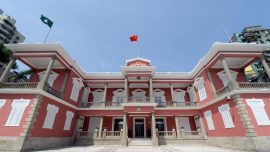Reviled by many as the face of the IRA during its campaign against British rule in Northern Ireland, Adams reinvented himself as a peacemaker in the troubled region and then as a populist opposition parliamentarian in the Irish Republic.
Adams said he would be replaced as party president, a position he has held since 1983, at a party conference next year. He would also not stand for reelection to the Irish parliament.
“Republicanism has never been stronger… But leadership means knowing when it is time for change. That time is now,” Adams said in an emotional speech to a packed party conference.
“I have complete confidence in the next generation of leaders,” he said.
Adams stayed on stage as the 2,500-strong crowd, some in tears, gave him a standing ovation and sang a traditional Irish song about the road home, followed by the national anthem.
Adams will almost certainly hand over to a successor with no direct involvement in the decades of conflict in Northern Ireland, a prospect that would make Sinn Fein a more palatable coalition partner in the Irish Republic where it has never been in power.
Deputy leader Mary Lou McDonald, an English literature graduate from Trinity College Dublin who has been at the forefront of a new breed of Sinn Fein politicians transforming the party’s image, is the clear favourite to take over.
That would mean the left-wing party being led on both sides of the Irish border by women in their 40s after Michelle O’Neill succeeded Martin McGuinness as leader in Northern Ireland shortly before the former IRA commander’s death in March.
IRA DENIALS
Adams, who will turn 70 next October, has always denied membership of the IRA but accusations from former IRA fighters that he was involved in its campaign of killings have dogged him throughout his career.
Adams was a key figure in the nationalist movement throughout the three decades of violence between Catholic militants seeking a united Ireland, mainly Protestant militants who wanted to maintain Northern Ireland’s position as a part of Britain, and the British army.
3,600 died in the conflict, many at the hands of the IRA.
As head of the political wing of the IRA during its bombing campaigns in 1980s Britain, Adams was a pariah and banned from speaking on British airwaves, forcing television stations to dub his voice with that of an actor.
He and his party emerged from the political cold in October 1997 when he shook hands with Labour Prime Minister Tony Blair at their first meeting. A year later, he helped win sceptical elements in the IRA to the Good Friday peace deal, which largely ended the violence.
Since the peace deal Adams and McGuinness turned Sinn Fein from a fringe party into the dominant Irish nationalist party in Northern Ireland and the third largest party in south of the border.
While its anti-austerity platform led to a six-fold increase in its number of seats in the Republic – 23 out of 158 – suspicion of Sinn Fein’s role in the Northern Ireland troubles still runs deep and the far larger ruling Fine Gael and or main opposition Fianna Fail have ruled out governing alongside them.
Analysts say a change of leader could help open the way to Sinn Fein entering government in Dublin for the first time.
“Under a new Sinn Fein leader I think anything is possible,” said David Farrell, politics professor at University College Dublin.
A new Sinn Fein leader will also take over responsibility for rescuing power-sharing devolved government in Northern Ireland and avoid a return to full direct rule from London for the first time in decade.
Power-sharing collapsed after Sinn Fein withdrew in January saying the Democratic Unionist Party was not treating it as an equal partner and a series of talks have failed to break the impasse.
By Conor Humphries























